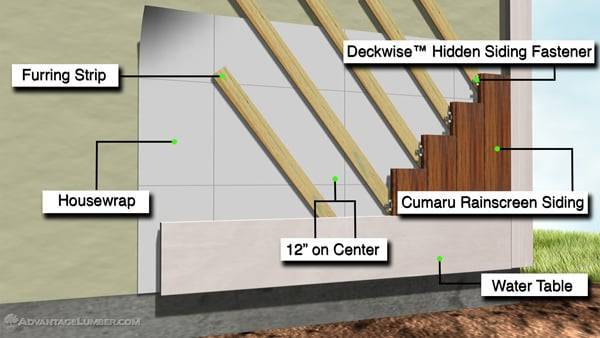
So you’ve decided Advantage Rainscreen Siding™ is the right choice for your home renovation project. The only problem is that you want your home to stand out amongst the crowd of run-of-the-mill looks. For an eye-catching look not seen in many homes, vertical installation* of rainscreen siding is a definite possibility. When you combine the warm and inviting look of real, natural Advantage Hardwoods with an application such as vertical siding, you can get the dynamic look you are aiming for. Although, exotic hardwoods have a much better resistance to rot, mold, and decay, vertical installations of any type of siding will increase the potential for water intrusion.
Proper Installation of the Furring Strips is Key
What’s the best way to install vertical siding while decreasing the chances of water retention? Install furring strips diagonally.
The diagonal furring strips need to be nailed at 12” on center and at a 45° angle. Start installing on the right and work your way to the left. This will still allow the airspace to get the ventilation it needs. With this placement of the furring strips you can install the siding vertical, horizontal, or in a pattern.
Advantage Rainscreen Siding™ Fasteners
Use rainscreen siding fasteners for easy installation. To install start at the corner using the starter clip that comes with your fastener kit, and attach it to the side. Fasten the siding to the furring strips, make sure to drive the stainless steel screw at a 45°, and then place the next piece of siding in to the fastener with the pre-molded groove. Use a level to ensure the boards are aligned properly. When dealing with outside corners, you can use a vertical siding corner post.
Can You Install Furring Strips Horizontally?
Horizontal furring strips are not something that I recommend. While typical siding installation require furring strips to be installed vertically, this is not the case when it comes to vertical siding installation. If vertical siding was set onto horizontal furring strips, any water that intrudes would have no place to go. With that much water retention, problems like rot and decay will lead to even more problems like air leaks. Even if you take the time to cut enough slits in the strips for drainage, there is still no guarantee that it will be sufficient enough for the rainscreen siding to ventilate properly. Stick with vertical or diagonal furring strip placement for the best possible outcome.
Diagonal furring strips can open up doors when it comes to rainscreen siding patterns. Don’t you want to own a house that your neighbors will envy? It will look spectacular and will also help your siding last for years and years.
*PRIOR TO INSTALLATION: Although vertical installation is a creative choice for your siding project, you run the risk of increased water intrusion since water will run the length of the siding and possible enter through any open grooves.*
I disagree with your water intrusion warning on vertical siding. Horizontal boards have a greater chance of water intrusion because it lands on the grain, pools and when the grain swells water enters. Vertical on the other hand will direct it along the grain, speeding the water down and away. I like your idea about diagonal furring strips but i’m taking it one step further and using plastic vented furring strips. Also if a penetrating oil based stain is used on the siding, the wood gets a natural water shedding system.
How do you do handle a But Joint with vertical rainscreen?
You could mill a lap joint on the ends of the boards with a hand held router.